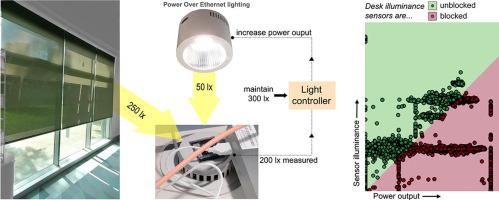Energy and Buildings ( IF 6.6 ) Pub Date : 2022-09-05 , DOI: 10.1016/j.enbuild.2022.112443 Michael Kent , Nam Khoa Huynh , Stefano Schiavon , Stephen Selkowitz

|
Daylight can reduce electric lighting in buildings. This is facilitated by sensors that relay real-time illuminance data to a light controller. When daylight provides greater than required or desired levels of illuminance, control actions enable electric lights to reduce their output and save energy. Occupant behaviours can block desk sensors and this reduces the amount of energy saved. However, no method exists that can be used to continuously monitor sensors to ensure they operate as intended (e.g. remain unblocked). We carried out a study in an open-plan office building in Singapore, consisting of 39 workstations each fitted with desk illuminance sensors independently controlling a dedicated ceiling light. Power over Ethernet was used to collect individual data signals for both illuminance and power from each workstation. Data were collected across a one month period, sampling signals at every 2-minute interval. A linear support vector machine model accurately classified 99% of the data points using our sensor blocking algorithm. From 447445 data points analysed, 12% of dataset showed that sensors were blocked and this had an estimated energy penalty of 24%. We do not recommend installing illuminance sensors at the desk. Our study highlights the usefulness of Power over Ethernet for closed-loop daylight harvesting. The data collected can be used to monitor the health of the sensors’ performance to help minimise energy use.
中文翻译:

使用支持向量机检测用于闭环日光采集的桌面照度传感器阻塞
日光可以减少建筑物中的电照明。传感器将实时照度数据传递给光控制器,这有助于实现这一点。当日光提供的照度高于要求或所需水平时,控制动作使电灯能够降低其输出并节省能源。乘员行为可能会阻挡桌面传感器,从而减少节省的能源量。但是,不存在可用于持续监控传感器以确保它们按预期运行(例如保持畅通)的方法。我们在新加坡的一栋开放式办公楼中进行了一项研究,该办公楼由 39 个工作站组成,每个工作站都配有独立控制专用吸顶灯的桌面照度传感器。以太网供电用于收集来自每个工作站的照度和功率的单独数据信号。数据在一个月内收集,每 2 分钟采样一次信号。线性支持向量机模型使用我们的传感器阻塞算法准确分类了 99% 的数据点。从分析的 447445 个数据点中,12% 的数据集显示传感器被阻塞,估计能量损失为 24%。我们不建议在办公桌上安装照度传感器。我们的研究强调了以太网供电对闭环日光采集的实用性。收集的数据可用于监控传感器性能的健康状况,以帮助最大限度地减少能源使用。12% 的数据集显示传感器被阻塞,估计能量损失为 24%。我们不建议在办公桌上安装照度传感器。我们的研究强调了以太网供电对闭环日光采集的实用性。收集的数据可用于监控传感器性能的健康状况,以帮助最大限度地减少能源使用。12% 的数据集显示传感器被阻塞,估计能量损失为 24%。我们不建议在办公桌上安装照度传感器。我们的研究强调了以太网供电对闭环日光采集的实用性。收集的数据可用于监控传感器性能的健康状况,以帮助最大限度地减少能源使用。











































 京公网安备 11010802027423号
京公网安备 11010802027423号